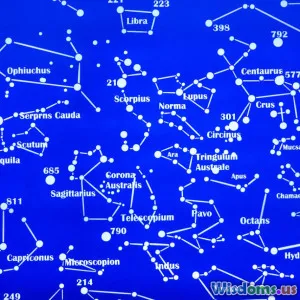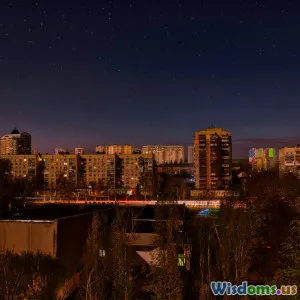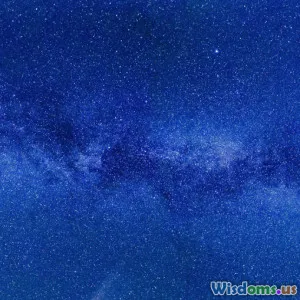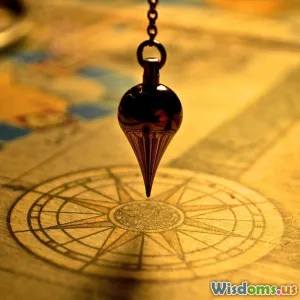
Journey through Time A Beginner’s Guide to Observing Ancient Light
8 min read Explore how to observe ancient cosmic light and unlock the universe's secrets in this beginner's astronomy guide. (0 Reviews)
Journey through Time: A Beginner’s Guide to Observing Ancient Light
Introduction: Peering Back in Time Through Light
Imagine holding a postcard in your hand sent from a distant city thousands of miles away—but the message took so long to arrive that you’re essentially reading a letter from the past. This is exactly how light from distant stars and galaxies reaches Earth, carrying information written billions of years ago. Observing this "ancient light" is effectively a journey through time, allowing astronomers, and curious enthusiasts alike, to study the origins and evolution of our universe.
As a beginner astronomer, understanding how ancient light reveals cosmic history can be both thrilling and enlightening. This guide will unpack how ancient light travels, the tools you can use to see it, and practical steps to start your own observations from backyard telescopes to accessible technology.
Understanding Ancient Light: What Does It Mean?
Light travels at a constant speed of about 299,792 kilometers per second—a cosmic speed limit. When you look at the night sky, you are not seeing celestial objects as they are now; you're seeing them as they were when the light left them.
For example, the sun is about 150 million kilometers away, so its light takes roughly 8 minutes to reach Earth. When you admire its brilliance, you're actually looking 8 minutes into the past. This delay increases dramatically with distance:
- The nearest star system, Alpha Centauri, is about 4.37 light years away—meaning its light began its journey long before humans existed.
- The Andromeda Galaxy, our closest spiral galaxy neighbor, lies some 2.5 million light years distant; the photons you see are ancient indeed, capturing Andromeda’s state millions of years ago.
Cosmic Archaeology via Light
This is why astronomers call their work a form of "cosmic archaeology." Ancient light serves as a time capsule, helping scientists reconstruct the universe’s timeline and understand processes such as star formation, galactic evolution, and even the Big Bang itself.
How Light Travels Across the Universe
Currently, our understanding places the observable universe at approximately 93 billion light years in diameter. This colossal scale presents both challenges and opportunities:
-
Redshift Phenomenon: As the universe expands, light waves stretch, shifting towards the red end of the spectrum—a vital clue for measuring cosmic distances and the age of observed objects.
-
Cosmic Microwave Background (CMB): The oldest electromagnetic light we can observe, dating back about 13.8 billion years, acts as a relic snapshot of the universe’s infancy, just 380,000 years post-Big Bang.
Essential Tools for Observing Ancient Light
Don’t worry if you don’t own an observatory or professional-grade telescope. Many ancient light phenomena are within reach of beginners using the right tools and techniques.
1. Binoculars
Starting simple, binoculars with 7x to 10x magnification can reveal star clusters, nebulae, and some galaxies. For instance, the Andromeda Galaxy is visible as a smudge on clear, dark nights.
2. Backyard Telescopes
For deeper exploration, a basic 4- or 6-inch reflector or refractor telescope opens new horizons. These affordable instruments permit observation of:
- Star nurseries where ancient light from newborn stars reveals stellar formation.
- Distant galaxies unveiling light that has traveled millions of years.
Example: The Whirlpool Galaxy (M51), approximately 23 million light years away, is a favorite target for beginners.
3. CCD Cameras and Smartphone Attachments
Modern advancements enable novice astronomers to capture faint ancient light. CCD (charge-coupled device) cameras installed on telescopes collect and amplify photon signals. Even smartphone adapters allow astrophotography to record detailed images.
Techniques to Enhance Your Observation
Knowing how to locate and interpret ancient light enriches your experience.
Star Charts and Apps
Utilize star map apps like Stellarium or SkySafari. They help pinpoint objects in the sky emitting ancient light based on your location and time.
Dark Sky Sites
Light pollution dramatically reduces visibility. Visiting rural areas or dark sky parks can reveal countless hidden stars and galaxies, making the journey through cosmic time vivid.
Long-Exposure Photography
Prolonging exposure times enables cameras to gather more photons, revealing incredible faint structures invisible to the naked eye.
Spectroscopy
For advanced beginners, science-grade spectroscopy kits allow the analysis of light spectra from stars and galaxies, identifying elemental compositions and motions.
Inspiring Real-World Insights
Notable scientific achievements spotlight the power of ancient light observation:
-
The Hubble Space Telescope has observed galaxies up to 13 billion light years away, revealing lights that started traveling shortly after the Big Bang.
-
The detection of gravitational waves complemented ancient light studies, offering novel ways to look back in cosmic time.
-
Citizen science projects, such as Galaxy Zoo, invite enthusiasts worldwide to classify galaxies observed through ancient light images.
Conclusion: Embarking on Your Own Time-Traveling Adventure
Observing ancient light is more than a hobby—it's a profound way to connect with the cosmos and our origins. Every photon hitting your eye or camera sensor carries a story of billions of years and unfathomable distances.
By starting with simple tools and nurturing curiosity, you step onto a personal voyage through time and space. Whether through powerful telescopes or humble binoculars, the universe invites you to witness its past and, ultimately, understand our place within this vast cosmic tapestry.
So, look up tonight, and embrace the light traveling eons just to meet your gaze—becoming your window to eternity.
Rate the Post
User Reviews
Other posts in astrophotography
Popular Posts


















